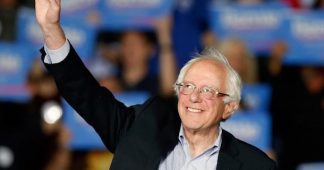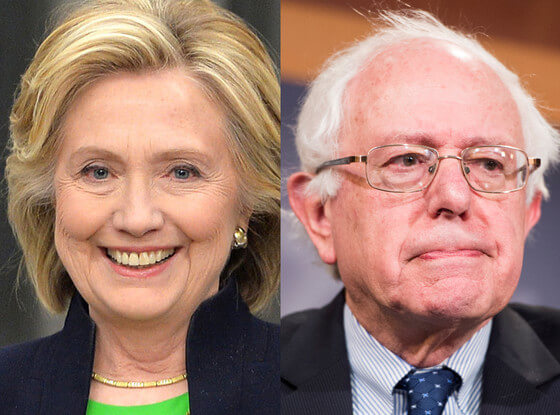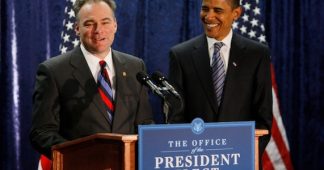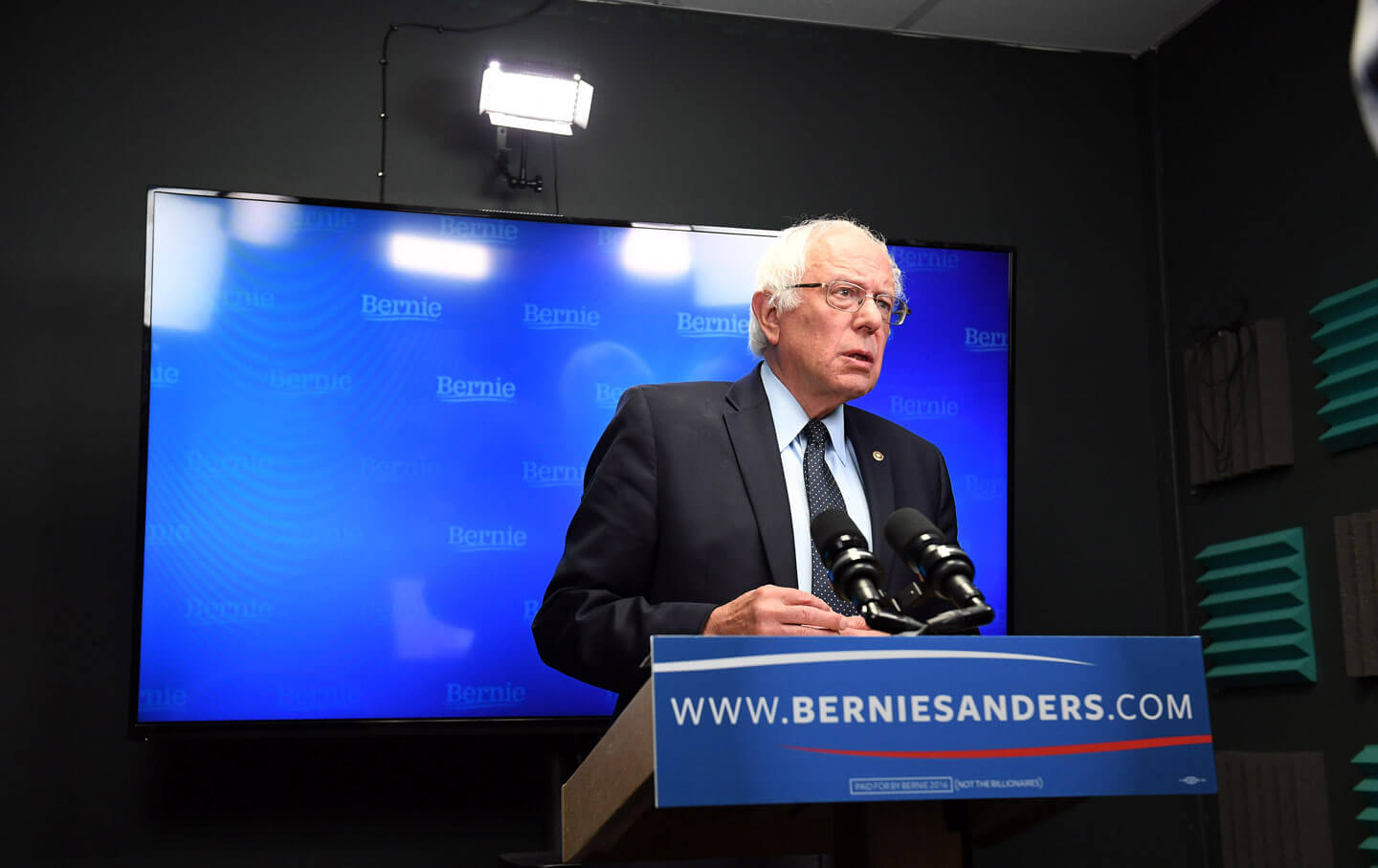By Patrick Iber
Original post date: 21 February 2017
or the American left, 2016 proved to be a year with a cruel twist ending. In the first few months, a self- described democratic socialist by the name of Bernie Sanders mounted a surprisingly successful primary challenge to the Democratic Party’s presumed and eventual presidential nominee, Hillary Clinton. By the end of 2016, however, not only had Sanders lost the primary race, but Clinton had been defeated in the general election by a billionaire who dressed his xenophobic and plutocratic ambitions in the garb of class resentment.
But the apparent strength of the left wasn’t entirely an illusion. Even as late as November, the Sanders campaign had racked up a set of important victories. The Cold War had helped to entrench the idea of socialism as antithetical to the American political tradition, and Sanders had gone a long way toward smashing that ideological consensus. By identifying himself explicitly as a democratic socialist from the outset of his campaign, he helped give renewed meaning and salience to it as a political identity firmly rooted in the American tradition.
In addition to helping end the stigma around socialism, the Sanders campaign provided a blueprint for a new generation of leftists and progressives. By running in the Democratic primary and showing that he could draw large crowds, Sanders revealed an emerging left-leaning constituency. It seemed in those early autumn months that even in defeat, Sanders had opened up the path for a more progressive Democratic Party: “Sanders Democrats” could continue to work within the party and not only protest outside it. The way forward seemed clear: After Clinton won the general election, a strengthened social-democratic left could work toward the universal provision of various social services and push for criminal-justice reforms and other key priorities.
But now, instead of holding a strengthened position within a troubled but relatively secure Democratic Party, the left appears to be simultaneously invigorated and institutionally irrelevant. The ambitious ideas and goals that have blossomed in recent years—single-payer health care, debt-free higher education, a $15-dollar-an-hour national minimum wage, paid leave, criminal-justice reform—seem to belong to a political world that no longer exists. The left is now primarily on the defensive: Rather than seeking to push the welfare state toward completion, it must defend against its dissolution. Rather than ensuring fair access to public goods like health care, education, and housing, the task of the left is now to prevent the wholesale pillage of the commons. And rather than merely restraining the hawks in the Democratic Party, the left must worry about global devastation, whether through nuclear action or climate inaction.
So what remains of 2016’s hoped-for “political revolution”? Two books by Sanders, Outsider in the White House and Our Revolution, and two volumes of essays by some of this new left’s leading voices, The ABCs of Socialism and The Future We Want, offer us some clues. While written with different conditions in mind, these books still serve as important references for thinking through how to move forward.
Sanders’s emergence as the de facto spokesman and moral conscience of the American left was nearly impossible to anticipate. In spite of having risen to the highest elected position of any socialist in US history, Sanders wasn’t viewed by many leftists as central to their projects and organizing efforts, most of which, in the early 2000s, were directed toward non-electoral goals and communities in urban areas. But the themes that Sanders struck—reducing economic inequality, fighting climate change and the corrosive influence of money in our politics—were well-chosen for our moment of economic upheaval and drew progressively larger crowds.
A careful account of Sanders’s story, and why he emerged so suddenly, will be the work of future historians. But he has written two campaign autobiographies that provide a reasonable first draft. Outsider in the White House was produced relatively quickly and published in 2015. Other than a new preface by Sanders and an afterword by The Nation’s John Nichols, it is essentially a retitled version of Outsider in the House, his 1997 book. Our Revolution, published in the days after Trump’s election, recapitulates the candidate’s biography but also gives us an account of his primary campaign against Clinton and concludes with a detailed policy agenda.
Both books provide similar accounts of Sanders’s life, but the earlier book offers a more complete portrait of his youth and political formation. Sanders was born into a lower-middle-class Jewish household in Brooklyn. The son of a paint salesman, he didn’t grow up in poverty but was conscious throughout childhood of the family’s lack of money. He attended Brooklyn College for his freshman year and then transferred to the University of Chicago, where he felt isolated among the children of businesspeople and professionals. By his own admission, Sanders wasn’t an especially good student, instead dedicating much of his time to activism with the university’s chapters of the Young People’s Socialist League and the Congress of Racial Equality.
The civil-rights movement was an important factor in Sanders’s politicization in the early 1960s. He participated in protests against the segregated housing owned by the University of Chicago, for which he was arrested, and in 1963 he made the long bus trip to Washington, DC, to attend the March on Washington for Jobs and Freedom, where Martin Luther King Jr. made his “I Have a Dream” speech. Sanders also joined the Student Peace Union and became involved in the antiwar movement. After college, he moved to Vermont and lived in rustic conditions. After joining the antiwar Liberty Union Party, a statewide socialist party founded in 1970, Sanders ran for the US Senate in 1972, winning just 2 percent of the vote. Four years later, he ran for governor, winning all of 6 percent.
Perhaps it was Vermont’s isolation from the civil-rights movement and other struggles of the era that made Sanders incline toward electoral politics rather than other forms of activism. Or perhaps it was simply that the Liberty Union Party’s leadership could fit into a living room, and he happened to be the one who volunteered for a Senate run. But at a time when New York–based socialists like Michael Harrington were forming the predecessors of today’s Democratic Socialists of America to push the Democratic Party to the “left wing of the possible,” Sanders was instead gaining experience in presenting socialist ideas as part of electoral campaigns. If many on the left had reconciled themselves to the task of trying to reform the Democratic Party from within in the 1970s, Sanders had decided to carry on the tradition of electoral socialism inherited from his idol, Eugene Debs.
Sanders’s first political success came in 1981, when—to nearly everyone’s surprise—he was elected as mayor of Burlington by a margin of 14 votes. But it wasn’t his own election that prompted him to first use his signature phrase “political revolution.” Elected on a platform that included protecting the environment and halting property-tax increases, Sanders soon found that Burlington’s board of aldermen was unwilling to work with him. So he decided that he needed to lead a “political revolution” in order to win more elections: this time to take aldermanic seats as well as the mayor’s office. In the following election, his Progressive Coalition ran candidates in every ward, an effort that found them knocking on nearly every door in the city. The Sanders forces won several of these races, and while they didn’t have a majority, they had enough seats to veto any Democratic or Republican initiative, forcing the traditional parties to work with them. “If the mayoral victory one year before had been regarded by some as a fluke,” Sanders writes, “there could be no mistaking what was happening now. A political revolution had occurred in Burlington.”
In Sanders’s time as mayor, Burlington became a small-town echo of the municipal socialism of the 1920s. He halted the property-tax increases, as promised, and raised revenue through a room-and-meal tax. A community land trust was set up to create affordable housing for low-income residents. There was also lakefront beautification and cultural renewal, with free blues, jazz, reggae, and country-music festivals, and events featuring left-wing luminaries like Studs Terkel and Noam Chomsky. Sanders also gave the city something of a foreign policy, traveling to Managua for the anniversary of the Nicaraguan Revolution, to the Soviet Union on his honeymoon in 1988, and to Cuba in 1989.
he question remained whether Sanders’s form of “political revolution”—the idea that mass organizing and local electoral victories could help push American politics to the left—could work on a scale larger than the municipal one. In 1990, Sanders ran successfully for the House of Representatives, where he served eight terms; in 2007, he was elected to the Senate, where he caucused, sometimes uneasily, with Democrats. He became the highest-ranking American politician to describe himself as a socialist.
Sanders remained out of step with the centrist politics of the Democratic Leadership Council, which dominated the party in those years. He was willing to endorse Bill Clinton for president in 1996 as preferable to Republican rule, but he did so without enthusiasm. He thought mainstream Democrats had abandoned the language of class, and he opposed DLC-championed trade deals like NAFTA, which served to place American workers in direct competition with the lower wages and regulatory standards outside the United States.
Once he arrived in the House of Representatives in 1991, Sanders helped set up the Progressive Caucus with Democratic allies like Peter DeFazio of Oregon, Lane Evans of Illinois, and Maxine Waters and Ron Dellums of California. He worked on adding progressive components to existing bills, and he wondered, as he watched the 1996 Republican National Convention produce a huge bounce in the polls, “What could happen, what would happen, in this country if progressives were allowed to have four or five nights of prime-time television and front-page newspaper coverage? What would happen if we could present a point of view that most Americans are unfamiliar with? Would we suddenly become the dominant political force in America? No. Would millions of Americans develop a much more sympathetic attitude toward democratic socialism? Yes.”
But it would be impossible to test his theory of political revolution from the confines of Congress. It required far more public attention, and a galvanizing campaign that would raise money and consciousness and inspire volunteers to put in work across the country. That could happen with a presidential campaign, the only realistic way to test his theory on a much larger scale. In 2015 and 2016, Sanders discovered—one suspects much to his own surprise—just how far he might be able to take this tactic.
If Sanders had won the presidency, he would have encountered, just as he had in Burlington in the early 1980s, a legislature consisting of Republicans and many Democrats who would have been unwilling to work with him or accept his victory as more than a fluke. The real test would have come in the 2018 midterms—analogous to those aldermanic elections—with pro-Sanders candidates running across the country, competing for every House seat and the contested Senate ones. But perhaps the most important aspect of Sanders’s run in the Democratic primary was cultural rather than electoral: He gave renewed vigor to the egalitarian ideals of socialism and, along the way, revealed a growing base of young voters who shared his enthusiasm for them.
Sanders defines democratic socialism in an idiosyncratic way: It is, above all else, fundamentally Rooseveltian—especially the Roosevelt of the never-implemented Second Bill of Rights in 1944. For Sanders, certain social goods—housing, education, and health care—deserve to be understood as rights rather than as commodities sold for profit. To achieve these ends, he sees the need to fight the power of concentrated wealth, which distorts both markets and politics in favor of the wealthy. But Sanders has another critique that is equally powerful and just as salient to our moment. His frequent invocation of the 1 percent and its undeserved share of the national wealth is not only an argument about economic inequality; it is also an argument about political inequality. One cannot be an equal member of a polity if those with wealth have far more say and far more power in the political system. A political democracy requires an economic democracy—or, as Sanders writes in Our Revolution, “today’s tyrannical aristocracy is no longer a foreign power. It’s an American billionaire class that has unprecedented economic and political influence over all of our lives.”
Sanders’s success with young voters reveals a bimodal distribution of socialist enthusiasm. The old guard that came of age in the 1960s, like Sanders, has now been met by a growing influx of organizers from the ranks of those born after 1980, people who have entered the workforce during years marked by varying degrees of capitalist crisis. The ABCs of Socialism, edited by Jacobin founder Bhaskar Sunkara, and The Future We Want, edited by Sunkara and The Nation’s Sarah Leonard, offer us some insights into the ways in which this new generation is attempting to redefine the socialist tradition for the 21st century.
The two books have much in common, sharing an editor and several authors. The ABCs of Socialism is a direct response to the surge of interest in socialism generated by the Sanders campaign. During his candidacy, subscriptions to Jacobin increased by the hundreds each week, and basic definitional and historical questions poured in. The ABCs of Socialism offers selections from the magazine, in the form of questions and relatively brief answers, to provide a useful history of the socialist ideal.
Enthusiastic though they were about the Sanders campaign, Jacobin’s writers are explicitly rooted in Marxism in a way that Sanders is not. For the authors in The ABCs, socialism means something more than his vision of a Rooseveltian social democracy. In their analysis, socialism cannot be achieved through progressive taxation and a more robust system of rights that decommodifies certain social goods; this would bend, but not break, the power of capital. And capital will always fight back, just as it has for the last 40-plus years, starting with the crises of the early 1970s, which created opportunities for businesspeople and their political allies (like Ronald Reagan and Margaret Thatcher) to fight the power of unions and the welfare state.
For Sanders, the problem is Wall Street and the billionaire class, which have captured the government and shaped the market to their advantage at the expense of ordinary workers. For Jacobin’s socialists, the problem is more acute: It is capitalism itself. In Our Revolution, Sanders defends the idea of capping the size of major banks and briefly discusses having the government support worker-owned businesses. But as Sunkara, going far beyond Sanders, puts it in his essay for The ABCs, the socialist vision remains “abolishing private ownership of the things we all need and use—factories, banks, offices, natural resources, utilities, communication and transportation infrastructure—and replacing it with social ownership, thereby undercutting the power of elites to hoard wealth and power.” That doesn’t mean the state will seize your “Kenny Loggins records,” Sunkara puckishly adds: Socialism requires the abolition of private property, not personal property.
One of socialism’s problems in the 20th century was that its existing examples—at least the ones claiming to have gone beyond social democracy—were always politically repressive single-party states. The new socialists neither deny this fact nor dwell on it. Instead, they focus on the ethical appeal of socialism. For Jacobin’s writers, so long as capitalism remains—even in the modified form of social democracy— injuries to human flourishing can be stanched, but not cured. It isn’t enough simply to expand the purview of the state if it leaves private property intact. But although the essays in The ABCs occasionally offer a Marxist critique of Sanders, they mostly articulate a view of socialism’s purpose that is similar to his own. As Sunkara puts it, the desired goal is “a world where people don’t try to control others for personal gain, but instead cooperate so that everyone can flourish.” Jacobin, which sometimes seems to take pride in being part of an unreconstructed left, more closely resembles the tradition of Marxist humanism that cropped up in the mid- to late 20th century, when actually existing socialism in the Soviet bloc too often proved to work against human flourishing. The point, after all, is to improve things.
If The ABCs seeks to establish a socialist ideal upon which to ground the left, The Future We Want is less theoretical and more focused on outlining the kinds of policies that might help to realize this ideal in our present moment. Collectively, the essays of The Future We Want think through how high-quality universal services, in an egalitarian context, would change human life.
Megan Erickson, in her essay “Imagining Socialist Education,” looks at our school system and argues that socialists must fight for universal access to the kind of liberating, decommodified education that members of the elite receive. In “Sex Class,” Sarah Leonard describes the importance of universal child care for socialist feminism—because otherwise the best that liberal feminism can offer will only be available to those who can pay. In “How to Make Black Lives Really, Truly Matter,” Jesse Myerson and Mychal Denzel Smith argue that overcoming the legacy of racism can only happen by closing the wealth gap between black and white Americans. To this end, they propose job guarantees and baby bonds that mature at 18 for all those born to families below the median net wealth.
Several of the book’s contributors mention the prospect of a universal basic income to cope with technological and social changes here and on the horizon, and to help manage the transition toward less work—the decommodification of life itself, and thus the weakening of the power of capital. But overall, the imagined interlocutor of these essays is neither on the left nor the right; it’s the sort of liberal who also seeks to reduce inequality, but would do so by increasing opportunity rather than reducing economic disparities. By highlighting the inequalities born out of liberal policies, the writers and editors of The Future We Want assert that the kind of goals that liberals and socialists share—greater formal equality, more egalitarian representation, a political system that doesn’t solely benefit elites—can only be realized through socialist means.
As we are no longer in a moment in which well-intentioned liberals are in power, these arguments will have to be repurposed. Donald Trump’s election has been a radicalizing experience for many: Subscriptions to the left’s magazines and membership in the Democratic Socialists of America increased throughout the Sanders campaign and jumped again after Election Day. But in spite of its energy and vigor, the left now needs to rethink some of its strategies and ideas. Total control of the government by the Republican Party, joined with Trump’s executive power, means that even massive mobilizations will produce defensive victories at best. Those victories are real and clearly worth the fight—not least because they produce solidarity—but the losses will still pile up. We are no longer debating a slower or longer path to social democracy; we are defending against the racist, misogynistic, and kleptocratic practices of a man committed to dismantling the New Deal.
But the left cannot sustain itself on defense alone. Other than doing what it can to stop Trump’s worst abuses, the left must develop a theory of change for a moment when the Democratic Party doesn’t control any branch of government. For a time, Sanders seemed to have shown us how to pull the Democratic Party to the left. Yet the vulnerability of his strategy was that it required the party’s more centrist wing to win the presidential election—which, as events have proved, isn’t something we can take for granted. Despite this defeat, the energy to resist—and to build—is there. If the Democrats are still afraid to speak of class, they will have to be taught. Those who cannot or will not stand up to Trump need to face primary challenges from the left. And even if the party’s next presidential candidate isn’t a progressive, the left needs to make clear in the intervening years that he or she will have to win over a sizable number of young voters who are.
Trump’s enormous unpopularity means that, assuming the continued existence of small-D democracy, the Democratic Party will win major elections in the future. The left’s job is to make sure that when it does, it will be a more egalitarian and progressive force. Until then, the broad left should focus on the common ground: civil rights, economic equality, universal services, and real democracy for all. Whatever Trump succeeds in dismantling, we must have the ideas at hand to rebuild it stronger and better once he’s gone. In short: What do we need to do next? Everything.











